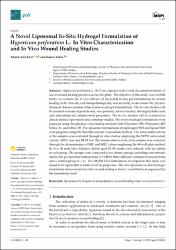A novel liposomal in-situ hydrogel formulation of hypericum perforatum L.: In vitro characterization and in vivo wound healing studies
Citation
Kurt, A.A.; Aslan, ˙I. A Novel Liposomal In-Situ Hydrogel Formulation of Hypericum perforatum L.: In Vitro Characterization and In Vivo Wound Healing Studies. Gels 2025, 11, 165.Abstract
Hypericum perforatum L. (H.P.) is a species with a well-documented history of
use in wound healing practices across the globe. The objective of this study was twofold:
firstly, to evaluate the in vivo efficacy of liposomal in situ gel formulations in wound
healing, both clinically and histopathologically, and secondly, to determine the physico chemical characterization of liposomal in situ gel formulations. The in vitro studies will
be assessed in terms of particle size, zeta potential, release kinetics, rheological behaviors,
and antioxidant and antimicrobial properties. The in vivo studies will be evaluated in
clinical animal experiments and pathology studies. The in-situ hydrogel formulations were
prepared using the physical cross-linking method with Poloxamer 188, Poloxamer 407,
Ultrez 21, and Ultrez 30. The liposome formulations phospholipid 90H and lipoid S100
were prepared using the thin film solvent evaporation method. The antioxidant activity
of the samples was evaluated through in vitro studies employing the DPPH antioxidant
activity, ABTS+ test, and FRAP test. The antimicrobial activity of the samples was evaluated
through the determination of MIC and MBC values employing the 96-well plate method.
In vivo, 36 male New Zealand rabbits aged 32–36 weeks were utilized, with six rabbits
in each group. The groups were composed of six distinct groups, including conventional
and in situ gel liposome formulations of HHPM, three different commercial preparations,
and a control group (n = 6). The HHPM-LG8 formulation developed in this study was
found to be applicable in terms of all its properties. The new liposomal in situ hydrogel
formulation demonstrated notable wound healing activity, a result that was supported by
the formulation itself.
Source
GelsVolume
11Issue
3URI
https://www.mdpi.com/2310-2861/11/3/165https://doi.org/10.3390/gels11030165
https://hdl.handle.net/20.500.12780/1083


















